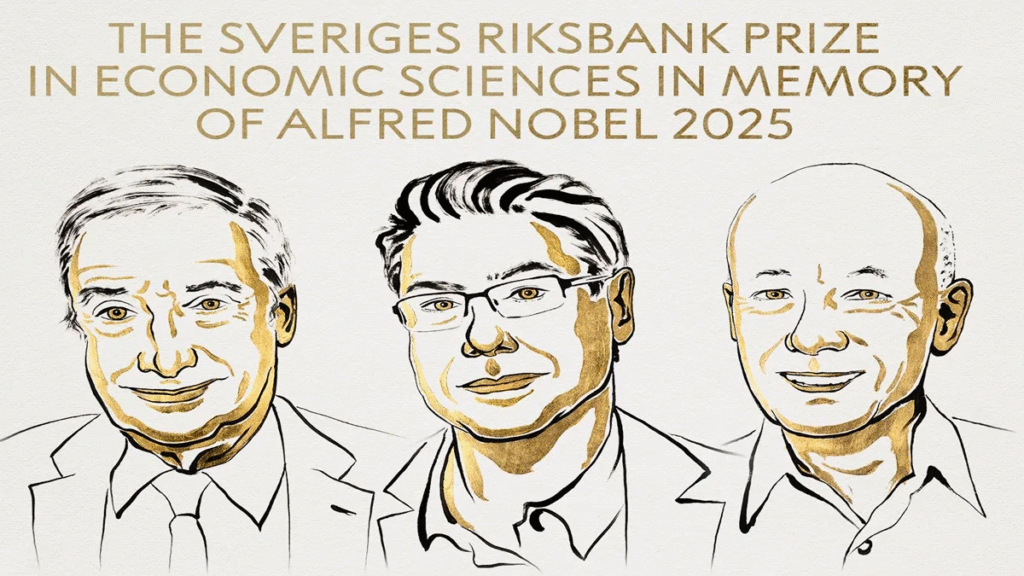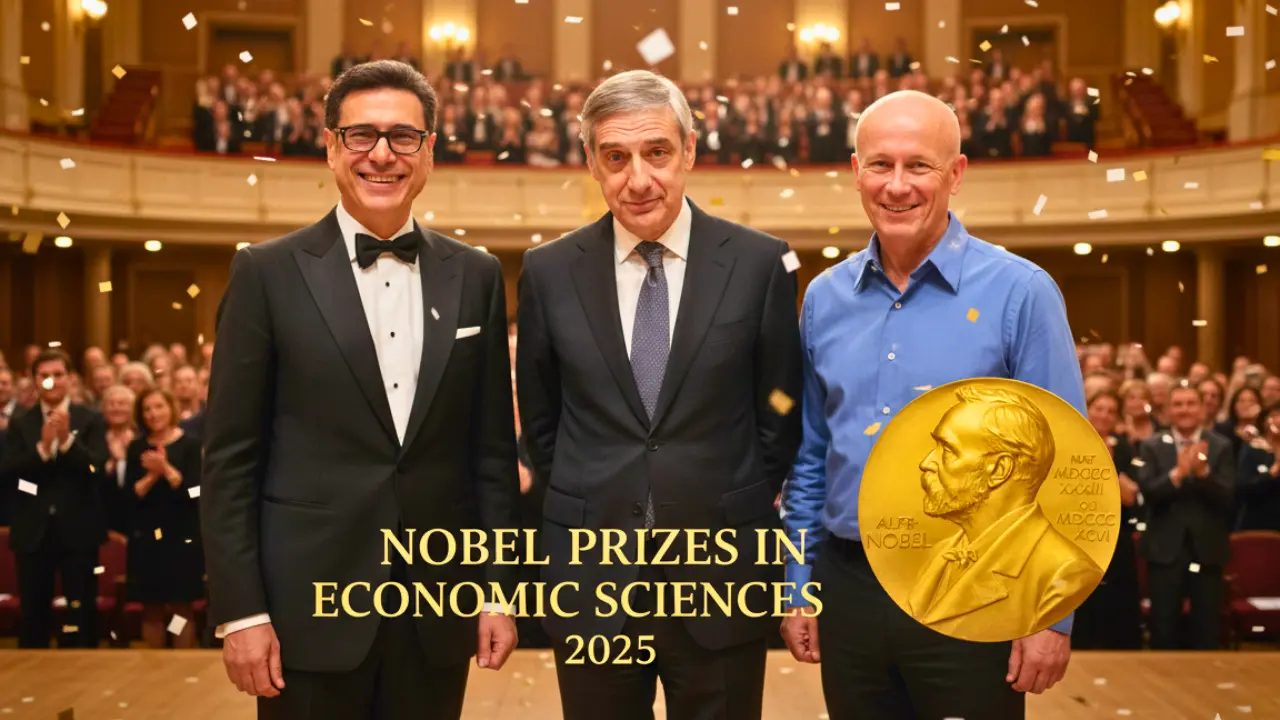The announcement of the 2025 Sveriges Riksbank Prize in Economic Sciences in Memory of Alfred Nobel has once again turned the spotlight on the foundational drivers of global prosperity. This year, the prestigious award—often simply called the Nobel Prizes in Economics—goes to three outstanding researchers: Joel Mokyr, Philippe Aghion, and Peter Howitt.
Their collective body of work provides a robust and compelling answer to one of humanity’s most enduring puzzles: Why did sustained economic growth begin, and what keeps it going today?
The Royal Swedish Academy of Sciences honored them “for having explained innovation-driven economic growth.” Mokyr’s half of the prize recognizes his historical work on the prerequisites for sustained growth through technological progress, while Aghion and Howitt share the other half for their rigorous mathematical model of “sustained growth through creative destruction.” This is more than academic theory; it’s a crucial framework for policymakers, entrepreneurs, and anyone interested in the future of global wealth.
Mokyr: The Historian Who Decoded Progress
Joel Mokyr’s research is a deep dive into economic history, tracing the roots of the Industrial Revolution and the subsequent centuries of continuous growth. His central insight is that true, sustained growth required a shift in how knowledge was valued and transmitted.
The Marriage of “Know-How” and “Know-Why”
Mokyr argues that, before the modern era, innovation was often based on “know-how”—practical knowledge of what worked—without the underlying “know-why”—a scientific explanation for why it worked.
- Pre-Industrial Stagnation: Discoveries were isolated, difficult to replicate, and impossible to build upon systematically. An inventor might figure out a better weaving loom, but without the science of materials or mechanics, that idea couldn’t easily spark a cascade of further improvements.
- The Enlightenment Shift: Mokyr highlights the shift that occurred when the scientific method began to underpin technology. Once innovations were supported by a systematic understanding of nature and principles, progress became self-generating. This fusion of propositional (scientific) and prescriptive (practical) knowledge created a “virtuous circle” of continuous improvement.
Mokyr’s work stresses that for this cycle to thrive, society must be open to new ideas and adaptable to change. Threats to continued growth—such as monopolies on knowledge or restrictions on academic freedom—must be actively countered. The statistic here is stark: For millennia, global economic growth was near zero.
It was only in the last two centuries, fueled by this intellectual revolution, that humanity experienced the “hockey stick” of exponential growth, lifting billions out of poverty.
Aghion and Howitt: The Calculus of Creative Destruction

If Mokyr explains how the engine started, Philippe Aghion and Peter Howitt explain how it continues to run. They provided a formal, mathematical model for Joseph Schumpeter’s famous concept of “creative destruction.” This theory is foundational to understanding modern capitalism.
The Dynamics of Innovation and Obsolescence
Creative destruction describes the process where new, superior innovations constantly replace outdated products, technologies, and even entire companies.
- Innovation (The Creative Part): A firm or entrepreneur introduces a radical new product or a vastly more efficient production method. Think of the smartphone replacing the flip phone, or online streaming replacing video rental stores.
- Destruction (The Destructive Part): The new innovation makes the old one obsolete, driving the existing firms that relied on the old technology out of business.
Aghion and Howitt’s key contribution was showing that this seemingly brutal cycle is not a sign of economic instability, but the very mechanism for sustained, long-run growth. Their model demonstrates that the expected profits from future innovation incentivize firms to invest in Research and Development (R&D). Without the possibility of destroying the old order, the incentive for new investment fades, and the economy stagnates.
Also Read: María Corina Machado Gets Nobel Peace Prize 2025: Her Triumphant Story
As Howitt himself has often stated, “Growth is intrinsically a disequilibrium process.” This means that policymakers shouldn’t try to stop the destruction; they should instead focus on policies that keep the flow of innovation robust and ensure that those displaced by the “destruction” part can transition smoothly into the jobs created by the “creative” part.
Real-World Relevance and Policy Implications
The work of the 2025 Nobel Prizes in Economics laureates holds enormous practical value. In an era dominated by rapid advancements in AI, biotech, and renewable energy, their insights are more critical than ever.
Key Takeaways for Policymakers
- Protecting Intellectual Openness: Mokyr’s work underscores that economic growth is fundamentally about the exchange and application of “useful knowledge.” Policy should prioritize funding for fundamental research, foster collaboration between academia and industry, and protect freedom of inquiry.
- Encouraging Competition: Aghion and Howitt’s model provides a strong argument against excessive market concentration. While temporary monopolies (patents) are necessary to reward risk-takers, prolonged monopolies can stifle the very innovation that drives growth. Policy must strike a delicate balance to encourage initial R&D without allowing entrenched firms to block disruptive newcomers.
- Investing in Human Capital: The Economic Times quoted a Nobel Committee statement emphasizing that the laureates’ findings “implicitly critique rigid social hierarchy,” stressing the need for the generalized dispersion of skills and the ability to apply scientific insights. A workforce trained in both abstract concepts and practical execution is essential. The consensus is clear: Invest in education and lifelong learning.
This focus on innovation-driven growth reflects a recent trend in the Nobel selection, which has increasingly recognized work addressing contemporary global challenges, following the 2023 award to Claudia Goldin on the gender gap in the labor market and the 2024 award on institutional prosperity.
Conclusion and Call to Action
The 2025 Nobel Prizes in Economics serves as a powerful reminder that our prosperity is not a given. It is a fragile, engineered outcome of a continuous, sometimes turbulent, cycle of creation and destruction, driven by a powerful feedback loop between science and technology. Joel Mokyr, Philippe Aghion, and Peter Howitt have gifted us the theoretical lens to understand this engine.
Now, the responsibility falls to policymakers and business leaders to apply these lessons—to foster open societies, support foundational research, and embrace the creative disruption necessary for a richer, more innovative future.
FAQs on the 2025 Nobel Prizes in Economics
Q1: Who won the Nobel Prize in Economics 2025?
The Sveriges Riksbank Prize in Economic Sciences in Memory of Alfred Nobel 2025 was awarded to Joel Mokyr, Philippe Aghion, and Peter Howitt.
Q2: What was the winning work in the 2025 Nobel Prizes in Economics?
The three laureates were honored “for having explained innovation-driven economic growth.” Mokyr’s work focused on the historical prerequisites for growth through technological progress, while Aghion and Howitt developed the modern mathematical theory of sustained growth through creative destruction.
Q3: What is “creative destruction” in economics?
“Creative destruction” is the process within capitalism where new innovations and technologies constantly replace—and thus destroy—older technologies, products, and firms. It is considered a necessary, albeit often painful, force for long-run economic expansion.
Q4: How does this prize selection compare to recent Nobel Prizes in Economics?
The 2025 prize continues a recent trend of recognizing work on contemporary, real-world issues. While the 2024 prize focused on institutions and prosperity, and the 2023 prize on labor market gender gaps, this year’s focus on innovation and technological progress is highly relevant to the current global focus on AI, R&D, and future economic engines.
Q5: Why is the work of these laureates important for a country’s economy?
Their work is vital because it shows that sustained prosperity is not guaranteed. It highlights that governments must actively cultivate the right environment—intellectual openness (Mokyr) and sufficient competitive incentive to innovate (Aghion & Howitt)—to prevent stagnation and ensure technology translates into broad economic benefit.
















